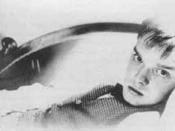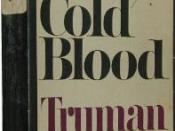Alexis Graesser
Mrs. Carney
English 11A
10 March 2014
Capote and Cold Blood
Throughout our brief history, there have been many prodigious writers. Ones who wrote poems, others who wrote tantalizing fiction, and those who spoke on behalf of the people who could no longer tell their story. Those writers used the world around them, the proceedings taking place, and a bit of their own style to influence their great works. The 1960s was one of the most turbulent decades in U.S. history and new styles of writing were being discovered and perfected. Truman Capote was no exception to those great writers finding who they were and what their style of writing was. That time period was stained with many imperfections but one stood out to Capote and lead to the writing of one of his best works of literature. A curious Capote used his style of "new journalism", events, such as the Clutter family murder, that took place in the late 1950s and the 1960s, and the novel In Cold Blood to change the face of literature for years to come.
Commended author Truman Capote was born Truman Streckfus Persons on September 30, 1924 in New Orleans, Louisiana to parents Lillie Mae and Archulus Persons. (Bio.) Some of Capote's childhood was spent in Monroeville, Alabama where he befriended To Kill a Mockingbird author Harper Lee. (Bio.) He ended up dedicating one of his most famous works, In Cold Blood to her, possibly for her help and encouragement pertaining to the novel and in return she sculpted Dill Harris' character around him. (Bio.) He attended private schools and eventually went to live with his mother and stepfather, Joseph Garcia Capote, in Millbrook, Connecticut, where he attended Greenwich High School. (Encyclopedia Britannica) An average student, Capote did well in the courses that struck his interest and paid little attention in those that did not. He had a gift for telling stories and entertaining people. (Bio.) Capote had begun secretly to write at an early age, and rather than attend college after completing high school, he pursued a literary apprenticeship and acquired his first job working as a copyboy for The New Yorker magazine.(Biography in Context) During this time, he tried to get his stories published there but had no success. (Bio.) He left The New Yorker to write full time, and started the novel Summer Crossing, which he took a break from to work on a story entitled Other Voices, Other Rooms. Capote's first successes were not his books, but short stories in which he won the O. Henry Memorial Short Story Prize for. (Capote) Capote's cumulative fixation with new journalism was reflected in the novel In Cold Blood, an unsettling account of a multiple murder committed by two killers in Holcomb, Kansas. Capote spent six long years interviewing important people involved in the case. (Encyclopedia Britannica) The success of this novel was also the peak of his career and arguably one of his best works. Although the topic of the book was quite morbid, "If he had known how long In Cold Blood would take- and what it would take out of him- he would have never stopped in Kansas, Truman Capote later wrote. He would have driven straight through- 'Like a bat out of hell.'" (Clarke) Capote also wrote and released other works during his time such as: Answered Prayers, Breakfast at Tiffany's, The Complete Stories of Truman Capote, The Grass Harp, Music for Chameleons, Other Voices, Other Rooms, and Too Brief A Treat: Letters of Truman Capote which was assembled by Capote biographer Gerald Clarke. (Capote) After many years of fighting alcoholism, drug addiction, and poor health, and he died on August 25 1984, in Los Angeles, California just over a month before his sixtieth birthday. (Biography in Context)
The Postmodernist Period in American literature was the time in which Capote was writing. (Biography in Context) This was a time of social reform, a call for civil rights, equal rights for women, and anti- war movements. (U.S. History in Context) The late 50s and early 60s were a time of optimism, liveliness, and wealth, a time when the United States assumed their place as a superpower and had a military that was not one to mess with. "It is a time for a new generation of leadership, to cope with new problems and new opportunities," the new president John F. Kennedy told the nation in 1960. "For there is a new world to be won." (Biography in Context) During his presidential campaign, Kennedy had promised the most ambitious domestic plan since Roosevelt's New Deal. This included laws and reforms that sought to eliminate injustice and inequality in the United States. (History) The political divisions and uncertainties of the 50s and 60s were displayed in the literature of that time. Writers came to terms with altered attitudes toward social involvement and government power, individual and minority rights and drug and alcohol abuse. (Michelson) While mostly whites voiced their opinions in the 1950s and 60s others took this time as an opportunity to add their voices to American ideas of distinct identity. (Michelson) These two decades were a great time of advances in literature; novels such as Ken Kesey's One Flew Over the Cuckoo's Nest, James Baldwin's The Fire Next, Alex Haley's The Autobiography of Malcom X, and Joyce Carol Oate's Expensive People were published.
Then came an event that shocked the nation, "All were shot in the head with a shotgun at close range and in addition the Clutter's throat was cut." (Greer) On November 15, 1959, Herb Clutter, his wife Bonnie, daughter Nancy, and son Kenyon were viciously slaughtered in their Holcomb, Kansas, home. The crime was committed Perry Edward Smith and Richard Eugene Hickock, who were then sent to the Kansas State Penitentiary. Soon after, the killers and the crime they committed became the subject of Truman Capote's novel, In Cold Blood. Capote directed a number of discussions with the convicts before they were sentenced to death by hanging on April 14, 1965. (McCarthy) "The desk was littered with what Dewey hoped would someday constitute courtroom exhibits: the adhesive tape and the yards of cord removed from the victims and now sealed in plastic sacksâ¦and photographs taken at the scene of the crime by a police office- twenty blown up glossy-print pictures of Mr. Clutter's shattered skull, his son's demolished face, Nancy's bound hands, her mother's death-dulled, still-staring eyes, and so on." (Capote pg. 83) This crime was cold blooded, hence the title of the book. Capote made the trip down to Holcomb to observe the crime for himself and write his intriguing novel. "As Truman Capote reconstructs the murder and the investigation that led to the capture, trial, and execution of the killers, he generates both mesmerizing suspense and astonishing empathy. In Cold Blood is a work that transcends its moment, yielding poignant insights into the nature of American violence." This description on the back of the book doesn't fail to accurately portray the way Capote depicted the brutality of the crime committed but does leave out the dedication Capote, with the help of friend Harper Lee, put into getting the facts and creating a thrilling novel.
Truman Capote is known for developing "New Journalism," a style of writing that was a cross between journalism and literature. (Bass) One of Capote's travel articles was an interpretation of an acting troop's tour of Russia called "The Muses Are Heard." He also did a satirical piece called "The Duke in His Domain," which strongly upset actor Marlon Brando. It was during the formation of this piece that Capote began to develop an unusual style of interviewing which he perfected in In Cold Blood, his first debut of "new journalism." (Bass) It was a technique Capote called "the secret to the art of interviewing." Capote's undisclosed technique was to tell his subject about himself, and then the subject would share his story with Capote. He also began to record details of interviews in his mind, without the use of traditional resources. Capote began to idealize a writing style with a unique formula. (Bass) Tom Wolfe identified four common narrative techniques that characterized Capote's style: detailed scene analysis, complete dialogue from interviews instead of biased quotes, point-of-view deviation, and details about the characters in the story. (Bass) Although tremendously enticing and popular novels, New Journalism creates a bothersome fix. Writers of "New Journalism" do not have the privilege of an all-knowing narrator. When they describe characters' thoughts they undertake an assumptive role. (Reynolds) In In Cold Blood for example, Perry rereads a letter from his father that was presented at a parole hearing. As Perry packs his most treasured belongings while leaving Mexico, Capote writes, "This biography always set racing a stable of emotions - self-pity in the lead, love and hate running evenly at first, the latter ultimately pulling ahead. And most of the memories it released were unwanted, though not all." (Capote, pg. 130) Capote interviewed Perry extensively, thereby allowing such an assumption to be affirmed.
The style of "new journalism", events that took place in the late 1950s and the 1960s, including the Clutter family murder, helped Truman Capote expand upon his career as an author. He thought to journalism and literature to develop a new style of writing which he perfected in his critically praised non-fiction novel In Cold Blood. He wrote a sufficient amount works in his time, a time in our history which was filled with changes and advances that inclined writers like Capote to work to their full potential. The release of In Cold Blood was the peak of Truman Capote's career and the start to a new outlook on literature.
BIBLIOGRAPHY
Capote, Truman. In Cold Blood. New York: Vintage Books, 1965. Print.
Bio. N.p., n.d. Web. 10 Mar. 2014. <http://www.biography.com/people/ truman-capote-9237547>.
Encyclopedia Britannica. N.p., n.d. Web. 8 Mar. 2014. <http://www.britannica.com/EBchecked/topic/94087/Truman-Capote>.
L., R. "Introduction." American Decades. Ed. Judith S. Baughman, et al. Vol. 7: 1960-1969. Detroit: Gale, 2001. U.S. History in Context. Web. 7 Mar. 2014.
History. History.com Staff, 2010. Web. 23 Mar. 2014. <http://www.history.com/ topics/1960s>. Norton Anthology of American Literature. Bruce Michelson, n.d. Web. 26 Mar. 2014. <http://www.wwnorton.com/college/english/naal7/contents/e/ welcome.asp>. |
Greer, Bob. "Clutter Family Slayings Shock, Mystify Area." Garden City Telegram [Garden City, Kansas] 16 Nov 1969, n. pag. Print.
Mental Floss. Erin McCarthy, n.d. Web. 17 Mar. 2014. <http://mentalfloss.com/ article/50958/15-details-cold-blood-killers%E2%80%99-case-files>.
UNCP. James Bass, n.d. Web. 18 Mar. 2014. <http://www2.uncp.edu/home/canada/work/allam/1914-/lit/capote.htm>.
Clarke, Gerald. Capote: A Biography. New York: Carrol and Graff Publishers,
1988. Print
"Truman Capote." Encyclopedia of World Biography. Detroit: Gale, 1998. Biography in Context. Web. 7 Mar. 2014
Yale. David Reynolds, n.d. Web. 26 Mar. 2014. <http://www.yale.edu/ynhti/curriculum/units/2006/3/06.03.09.x.html>.


